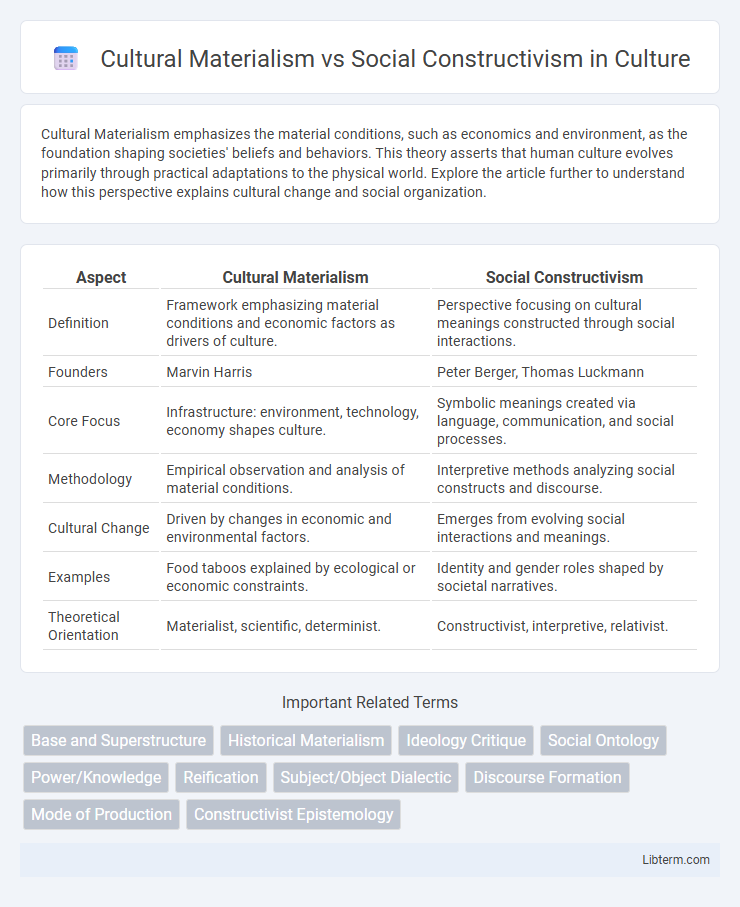Cultural Materialism emphasizes the material conditions, such as economics and environment, as the foundation shaping societies' beliefs and behaviors. This theory asserts that human culture evolves primarily through practical adaptations to the physical world. Explore the article further to understand how this perspective explains cultural change and social organization.
Table of Comparison
| Aspect | Cultural Materialism | Social Constructivism |
|---|---|---|
| Definition | Framework emphasizing material conditions and economic factors as drivers of culture. | Perspective focusing on cultural meanings constructed through social interactions. |
| Founders | Marvin Harris | Peter Berger, Thomas Luckmann |
| Core Focus | Infrastructure: environment, technology, economy shapes culture. | Symbolic meanings created via language, communication, and social processes. |
| Methodology | Empirical observation and analysis of material conditions. | Interpretive methods analyzing social constructs and discourse. |
| Cultural Change | Driven by changes in economic and environmental factors. | Emerges from evolving social interactions and meanings. |
| Examples | Food taboos explained by ecological or economic constraints. | Identity and gender roles shaped by societal narratives. |
| Theoretical Orientation | Materialist, scientific, determinist. | Constructivist, interpretive, relativist. |
Introduction to Cultural Materialism and Social Constructivism
Cultural Materialism emphasizes the material conditions of society, such as technology, environment, and economic factors, as primary determinants of social structure and cultural development. Social Constructivism argues that knowledge and meaning are created through social interactions and shared understandings rather than objective reality alone. These frameworks offer contrasting approaches to analyzing human behavior: one grounded in tangible resources and infrastructure, the other in language, ideology, and social context.
Historical Origins and Development
Cultural materialism, rooted in Marvin Harris's work in the 1960s, emphasizes the role of material conditions such as environment, technology, and economic factors in shaping cultural practices and social structures. In contrast, social constructivism emerged from the sociological and postmodernist traditions in the late 20th century, highlighting how knowledge, reality, and social phenomena are constructed through language, interaction, and power relations. Both frameworks evolved to explain human behavior and society but diverge on prioritizing either empirical material factors or subjective meaning-making processes.
Core Principles of Cultural Materialism
Cultural Materialism emphasizes the primacy of material conditions, such as economic practices and environmental factors, in shaping human culture and social structures. It asserts that infrastructure, including technology and modes of production, determines social structure and ideology as superstructural elements. This approach contrasts with Social Constructivism by prioritizing tangible, empirical evidence over interpretive or subjective cultural meanings.
Key Tenets of Social Constructivism
Social constructivism emphasizes that knowledge and meaning are co-created through social interactions and cultural contexts, highlighting the role of language, communication, and shared experiences in shaping understanding. It asserts that reality is not objective but constructed by individuals within particular social environments, influencing cognition and behavior. Central to this theory are concepts such as situated learning, scaffolding, and the internalization of cultural tools that facilitate knowledge acquisition.
Methodological Approaches: Materialism vs. Constructivism
Cultural Materialism employs a methodological approach centered on material conditions, emphasizing tangible factors such as economic practices, environmental constraints, and technological advancements to explain cultural phenomena. Social Constructivism, in contrast, adopts a constructivist methodology that prioritizes human cognition, social interactions, and shared meanings as the primary drivers behind the formation of cultural beliefs and institutions. These contrasting approaches highlight the materialist focus on objective, measurable elements versus constructivism's emphasis on subjective interpretations and social context in cultural analysis.
Influential Theorists and Major Works
Cultural Materialism, prominently developed by Marvin Harris in his seminal work *Cultural Materialism: The Struggle for a Science of Culture* (1979), emphasizes material conditions such as environment, technology, and economy as primary drivers of cultural practices. In contrast, Social Constructivism, influenced by theorists like Peter L. Berger and Thomas Luckmann, is extensively articulated in *The Social Construction of Reality* (1966), focusing on how knowledge and social realities are constructed through human interactions and language. Both frameworks have profoundly impacted anthropology and sociology by providing distinct lenses to analyze culture, with Harris's materialist approach grounding culture in tangible factors and Berger and Luckmann's constructivism highlighting subjective social processes.
Comparative Analysis: Ontology and Epistemology
Cultural Materialism posits that material conditions and economic factors fundamentally determine societal structures and behaviors, emphasizing an objective ontology grounded in tangible realities. Social Constructivism asserts that knowledge and social phenomena are co-created through human interactions, promoting a subjective ontology centered on constructed meanings. Epistemologically, Cultural Materialism relies on empirical observation and scientific methods, while Social Constructivism prioritizes interpretive understanding and the context-dependent nature of knowledge.
Case Studies: Applications in Social Sciences
Cultural Materialism case studies emphasize the role of economic and environmental factors in shaping social structures, such as Marvin Harris' analysis of cattle worship in India demonstrating material conditions influencing religious practices. Social Constructivism case studies explore how social realities are created through language and shared meanings, like Berger and Luckmann's investigation of knowledge formation within social institutions. These approaches reveal contrasting methodologies for analyzing cultural phenomena in anthropology, sociology, and other social sciences by focusing on material determinants versus socially constructed realities.
Criticisms and Limitations of Each Perspective
Cultural materialism faces criticism for overemphasizing economic and environmental factors while neglecting the symbolic and cognitive dimensions of culture. Social constructivism is limited by its potential to underplay material realities and power structures, often leading to subjective interpretations that lack empirical grounding. Both perspectives struggle with balancing the influence of tangible resources and social meanings in shaping human behavior and societal development.
Conclusion: Implications for Contemporary Research
Cultural Materialism emphasizes the influence of material conditions and economic factors on societal development, offering empirical approaches that prioritize observable data in contemporary research. Social Constructivism highlights the significance of social interactions and shared meanings, encouraging qualitative methods that explore subjective experiences and ideologies. Integrating both perspectives can enhance interdisciplinary studies by balancing objective analysis with contextual understanding of cultural phenomena.
Cultural Materialism Infographic

 libterm.com
libterm.com